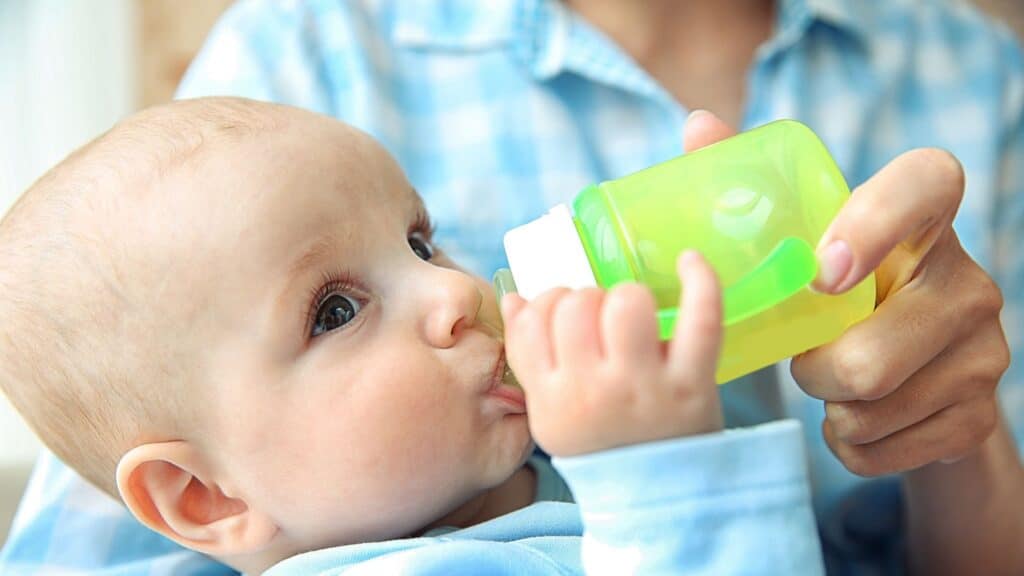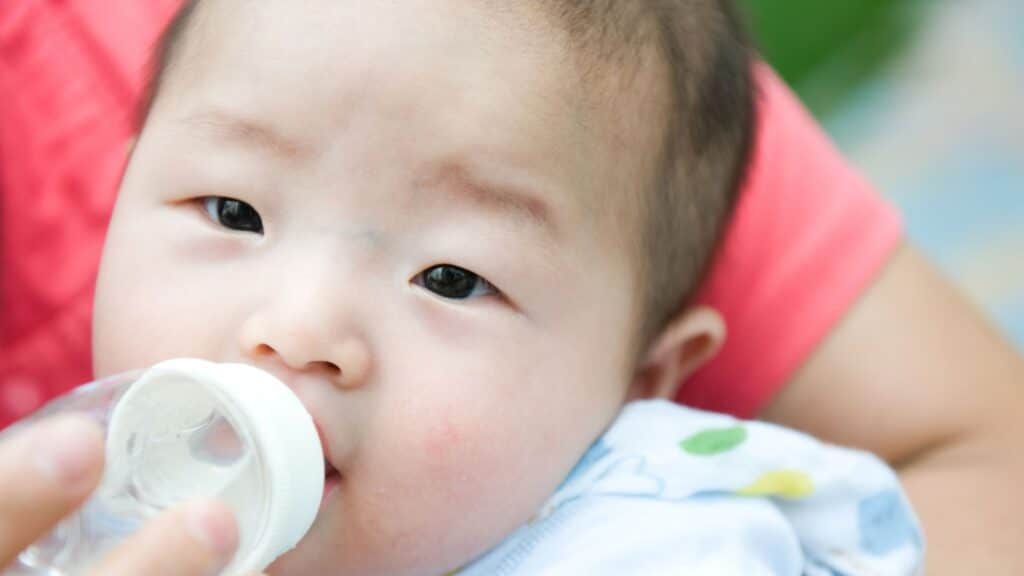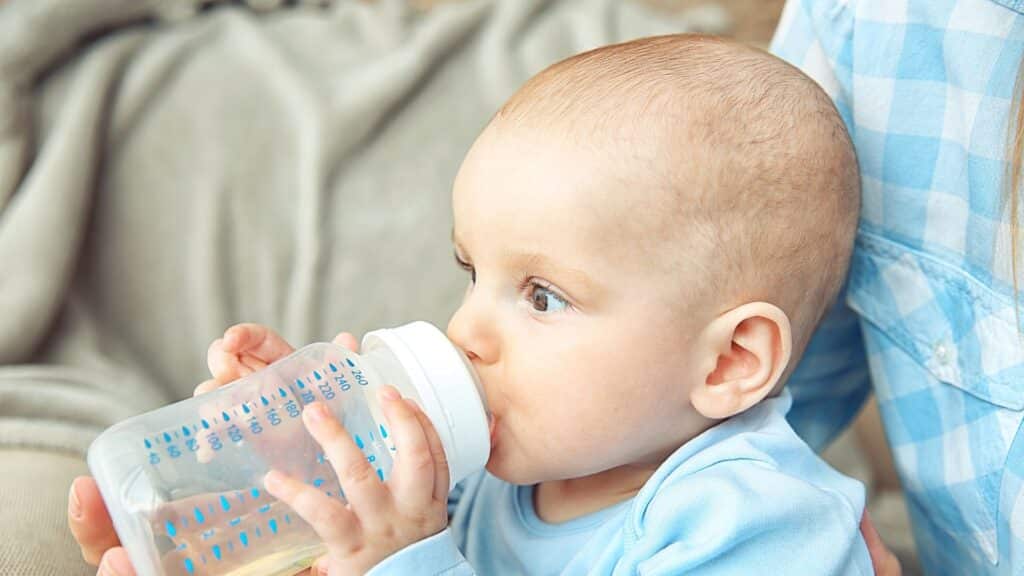If you are a new parent, understanding the hydration needs of your baby can be a complicated journey teeming with uncertainties. In essence, providing the right amount of water at the right time is part of ensuring their overall development and well-being.
This guide aims to simplify that journey, from exploring the role of hydration in early development to practical tips for hydrating infants. Let’s dive into the world of infant hydration.

The Role of Hydration in Early Development
Water has a comprehensive and crucial role in the human body. Some of its roles are quite prevalent, and others are more nuanced. During the initial development stages, hydration is especially vital. This section covers how hydration supports various physiological functions and how it influences cognitive and physical growth.
How Hydration Supports Various Bodily Functions
Water, or better said, hydration, plays several indispensable roles within the body, such as:
- Regulating Body Temperature: Water helps maintain a consistent body temperature through processes like sweat production and respiration.
- Transporting Nutrients: Water is the primary carrier for nutrients around the body, ensuring that each cell gets what it needs.
- Cushioning and Lubricating: Water helps protect tissues, spinal cord, and joints by acting as a cushion and a lubricant.
- Encouraging Cell Growth and Reproduction: For cells to reproduce and grow, they need a balanced and hydrated environment.
- Eliminating Waste: Hydration helps with the elimination of waste from the body through urine and other excretory processes.
Hydration’s Influence on Cognitive and Physical Growth
Early childhood is a time of rapid cognitive and physical growth. Hydration has an important influence on these two aspects.
- Cognitive Growth: Studies have shown that even mild hydration could have a considerable impact on cognitive functions, such as attention, executive function, and motor skills, among children. Energy level, mood, and memory are also positively impacted by appropriate hydration.
- Physical Growth: Proper hydration is essential for the body’s physical development since hydration aids in the maintenance of muscle tone and joint flexibility and supports growth rate. Dehydration, even mild, can harm physical performance and the body’s growth process.
Hydration’s role in early development is profound and wide-reaching. It not only supports various bodily functions but also contributes substantially to both cognitive and physical growth during childhood. Ensuring adequate hydration and staying hydrated are of utmost importance. Babies should also have enough fluids, including baby water, to support their development.
Deciphering Your Baby’s Hydration Signals
Babies rely on their caregivers for essential needs such as food and hydration. Deciphering baby signals can be a challenge for new parents. Babies can’t tell when they are thirsty or hungry. Therefore, it’s essential to recognize the signals they emit when they need to stay hydrated.
Identifying Signs of Thirst in Infants
Infants communicate their thirst and other needs to their caregivers in various ways, including:
- Mouth Movements: A baby expressing thirst might display strong sucking movements, put their fists in their mouth, or lick their lips.
- Attention to Bottle/Breast: If a baby is thirsty, they show a keen interest in the bottle or breast right when seeing it, indicating a need for bottle feeding.
- Restlessness: Babies often become fussy or irritable if they are thirsty. This can also be a symptom of other discomforts, so it’s crucial to monitor for other signs as well.
- Dry Diapers: Infrequent urination or dry diapers for significant phases can be a sign of insufficient fluid intake.
Differentiating Between Hunger and Thirst Cues
Differentiating between hunger and thirst cues in babies can be tricky as several signals overlap. Here are a few distinctions:
- Hunger Signals: These generally involve behaviors like opening their mouth when they see a spoon approaching, making chewing movements, or getting excited when they see food. Crying is often a late signal of hunger, not an early one.
- Thirst Signals: These might include lip smacking, rapid breathing, a dry mouth, and sleeping poorly. Babies may also show fussiness and cry with high-pitched or piercing sounds.
It is crucial to not solely depend on these signs, as babies vary in behaviors, and these could be symptoms of other discomforts. Continually monitoring their habits and consulting with a pediatrician is advisable for optimal infant care. To ensure adequate hydration, one should be mindful of these signs and follow a frequent bottle feeding routine.

Dispelling Common Myths about Infant Hydration
There are several misconceptions about infant hydration, especially concerning the introduction of water. Addressing these myths and clarifying when and how to introduce water can guide parents toward better hydration practices for their babies.
Addressing Misconceptions about Introducing Water
Here are a few common misconceptions and facts about introducing water to infants:
- Myth: Newborns need water in addition to breast milk/formula.
- Fact: Breast milk or infant formula provides all the necessary hydration for babies under six months of age. Offering water at an early stage can fill up their small stomachs, leaving less room for nutrient-rich milk.
- Myth: Providing water helps with constipation in babies.
- Fact: While water does help with constipation in older children and adults, it’s not recommended for infants under six months. Instead, a slight change in diet or feeding patterns can often help.
- Myth: Water is essential in hot weather to prevent dehydration.
- Fact: Breast milk or formula is enough to keep a baby hydrated even in hot weather. However, during periods of high heat, infants might need to nurse more often.
Clarifying When and How Water Should Be Introduced
According to pediatric guidelines, water should only be introduced to a baby’s diet after they reach six months of age. These are a few recommendations on how this should be done:
- Gradual Introduction: Start by offering small amounts of water, no more than two ounces at a time, twice a day.
- Use of Suitable Cup: Introduce water using a small, baby-sized cup to help infants learn to sip.
- Consistency: Link water consumption to daily activities, such as meals, to establish regular hydration habits.
- Monitoring Reactions: Keep a close eye on changes in your baby’s digestion or urination. If any concerns arise, reach out to your pediatrician promptly.
It’s essential to remember that while water eventually becomes an important part of a child’s diet, the initial stages of life are adequately supported by breast milk or formula. Always consult with healthcare professionals for specific recommendations based on your baby’s specific needs.

Guidelines for Safely Offering Water to Your Baby
Ensuring proper hydration for your infant is essential. As your baby grows older, introducing water correctly becomes a critical aspect of their development and health.
The Appropriate Age for Introducing Water
According to the World Health Organization and many pediatricians:
- Under six months: Infants under six months should not be given additional water. Their hydration needs are completely met by breast milk or formula.
- 6-12 months: Once the baby starts eating solid foods (around six months of age), small amounts of water can be introduced. However, the primary fluid intake should still be breast milk or formula.
- Over 12 months: After the first year, when the baby’s diet includes a significant amount of solid foods, water can take up a more substantial role.
Safe Water Sources and Preparation Methods
When it’s time to introduce water, you’ll need to ensure it’s safe and suitable for your baby’s sensitive digestive system. Here are a few tips:
- Choose Suitable Water: Tap water is often a good choice, as it contains minerals that are beneficial for your baby. However, it should be free of contaminants. Bottled water may be a suitable option, although some brands may have high mineral contents that aren’t ideal for babies.
- Boiling Water: For infants under 12 months, it’s recommended to boil the water first, then let it cool down to a safe temperature. This process helps kill any potentially harmful bacteria.
- Avoid Sweetened Drinks: Water is the best choice for extra hydration. Try to limit the intake of sweetened drinks, as these can lead to tooth decay and unhealthy weight gain.
It’s essential to follow these guidelines to ensure your baby stays healthy and well-hydrated. Always remember to consult a healthcare professional if you’re unsure about the right steps to take
Practical Tips for Hydrating Your Infant
Ensuring healthy hydration habits for your baby involves adequately understanding when and how to offer water. It’s not just about providing a few ounces of fluids, but navigating breastfeeding/formula routines effectively, and incorporating age-appropriate drinking methods. This way, you facilitate your infant to maintain a healthy fluid balance, staying well-hydrated and adapting comfortably.
Navigating Water Introduction Alongside Breastfeeding/Formula
While introducing water to your infants, notably those babies younger than six months, it’s crucial to continue providing breast milk or formula for optimum development. Here are some proven tips for maintaining this balance:
- Offer Water in Between Feedings: Providing your infant with small amounts of water during increments unrelated to their milk intake times is advisable. The baby experiences hydration separately from breastfeeding or formula feeding.
- Observe Fluid Intake: Keeping track of how much water your baby consumes alongside breast milk/formula each day can help ensure they’re getting the correct amount of fluid. Look out for regular wet diapers as a good sign of their hydration level.
- Avoid Overhydration: Though water supports healthy development, overconsumption can lead to an imbalance in nutrients. You want to offer only an appropriate amount of water based on their age.
- Consult a Pediatrician: Regular medical consultations are necessary to confirm proper hydration levels and receive guidance on adjusting fluid intake as your baby grows. Keep an eye out for concentrated urine, which may be a sign of underhydration.
Gradually Incorporating Sippy Cups and Other Drinking Methods
As your baby grows, introducing new drinking methods can help them develop better motor skills, easing the transition to regular cups. Here are some steps to guide you:
- Try Different Cup Types: Around 6-9 months, try introducing a sippy cup or a cup with a soft, built-in straw. It teaches your baby different ways to take liquids.
- Support Baby’s Grip: Opt for small, baby-sized cups with handles or ergonomic grips. This design makes them easier for your infant to hold and manage.
- Transition Gradually: When introducing new drinking methods, do it slowly. Offer water in the new container first, allowing your baby to adapt to the change at their own pace.
- Observe and Adjust: It is crucial to monitor your baby’s progress and make any necessary adjustments. Some infants may need to try different cup types before they find one best suited to their learning curve.
Incorporating these practical tips can help you ensure your baby maintains a healthy fluid balance, adapting to their evolving nutritional requirements while learning new skills. Remember, an adequately hydrated baby is a happy baby. Remember, babies should not consume energy drinks. According to the American Academy of Pediatrics, energy drinks are not suitable for children and adolescents.

Hydration Challenges and Solutions
It’s quite common for parents to face challenges when introducing water to their infants. The key lies in understanding these hurdles and finding effective solutions that ensure your baby remains adequately hydrated.
Dealing with Refusal to Drink Water
Sometimes, babies might refuse to consume water, leading to concerns about whether they’re sufficiently hydrated. Here are some solutions:
- Try Different Temperatures: Like adults. Some babies may prefer their water warm, cold, or at room temperature. Experiment with various water temperatures to see which one your baby is more receptive to.
- Introduce a Variety of Cups: If your baby refuses water from a specific bottle or cup, try offering it in a different container. They may prefer a different shape, color, or type of spout.
- Incorporate Hydrating Foods: If your baby consistently refuses to drink water, incorporate water-rich foods like cucumbers, watermelon, or oranges into their diet to ensure they receive hydration.
- Follow the ‘Little and Often’ Rule: Instead of offering large amounts at once, give small sips of water throughout the day. This method can help your baby slowly get accustomed to the taste.
Overcoming Potential Hurdles in the Hydration Journey
Even after successfully introducing water to your baby, you may encounter other challenges. Here’s how you can navigate these common issues:
- Excessive Spillage: Babies trying to drink from a cup for the first time often spill water. Be patient, as this is part of their learning curve, and have cleaning supplies handy for quick cleanups.
- Preference for Milk or Juice: Babies might prefer the taste of milk or juice over water. Encourage water intake by explaining its importance and limiting the intake of sweet drinks to mealtimes.
- Frequent Urination: With increased water intake, babies may urinate more frequently. Ensure you’re changing their diapers promptly to maintain hydration levels and prevent skin irritation.
Consider these hurdles as part and parcel of your baby’s growth and learning phase. With a bit of patience, consistency, and creativity, you can ensure your baby stays well-hydrated and adapts to consuming water regularly.
Conclusion
In sum, understanding your baby’s unique hydration needs is paramount for their overall development and well-being. From recognizing signs of thirst to introducing water alongside breast milk or formula, each step affects your infant’s hydration status.
Through this guide, you’ve learned about the vital role of hydration during early development, how to decipher your baby’s signals for thirst, and when to introduce water into their diet. Furthermore, we’ve explored safe water sources, practical tips for hydration, challenges, and the role of professional consultation in tailoring your baby’s hydration plan.
However, remember to maintain a fine balance without overhydrating and to consult with your pediatrician for personalized advice. Just as each baby is unique, so are their hydration needs. Therefore, to nurture them lovingly and responsibly, we must be flexible, observant, and responsive to their cues.
Hydrating your baby, therefore, is not merely about providing fluids; rather, it’s a nuanced process that changes, adapts, and contributes significantly to essential milestones in your baby’s life. Remember, hydration is critical, as water is the source of life, and providing it to your baby at the right time, in the right amounts, is one of the greatest gifts you can give for their healthful growth and development.
Did this article help you? Please let me know by commenting below, and don’t hesitate to ask if you have any questions.



